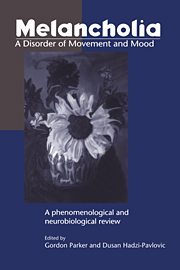Book contents
- Frontmatter
- Contents
- List of contributors
- Acknowledgments
- Introduction
- Part One Classification and Research: Historical and Theoretical Aspects
- Part Two Development and Validation of a Measure of Psychomotor Retardation as a Marker of Melancholia
- 5 Psychomotor Change as a Feature of Depressive Disorders: Historical Overview and Current Assessment Strategies
- 6 Development and Structure of the CORE System
- 7 Reliability of the CORE Measure
- 8 Validity of the CORE: I. A Neuroendocrinological Strategy
- 9 Validity of the CORE: II. Neuropsychological Tests
- 10 Validity of the CORE: III. Outcome and Treatment Prediction
- 11 Phenotypic Expression of Melancholia Contrasted for Those with Bipolar and Unipolar Illness Courses
- 12 Psychotic Depression: Clinical Definition, Status and the Relevance of Psychomotor Disturbance to Its Definition
- 13 A Clinical Algorithm for Defining Melancholia: Comparison with Other Sub-typing Measures
- 14 Rating the CORE: A User's Guide
- Part Three The Neurobiology of Melancholia
- The CORE Measure: Procedural Recommendations and Rating Guidelines
- References
- Author Index
- Subject Index
13 - A Clinical Algorithm for Defining Melancholia: Comparison with Other Sub-typing Measures
from Part Two - Development and Validation of a Measure of Psychomotor Retardation as a Marker of Melancholia
Published online by Cambridge University Press: 04 August 2010
- Frontmatter
- Contents
- List of contributors
- Acknowledgments
- Introduction
- Part One Classification and Research: Historical and Theoretical Aspects
- Part Two Development and Validation of a Measure of Psychomotor Retardation as a Marker of Melancholia
- 5 Psychomotor Change as a Feature of Depressive Disorders: Historical Overview and Current Assessment Strategies
- 6 Development and Structure of the CORE System
- 7 Reliability of the CORE Measure
- 8 Validity of the CORE: I. A Neuroendocrinological Strategy
- 9 Validity of the CORE: II. Neuropsychological Tests
- 10 Validity of the CORE: III. Outcome and Treatment Prediction
- 11 Phenotypic Expression of Melancholia Contrasted for Those with Bipolar and Unipolar Illness Courses
- 12 Psychotic Depression: Clinical Definition, Status and the Relevance of Psychomotor Disturbance to Its Definition
- 13 A Clinical Algorithm for Defining Melancholia: Comparison with Other Sub-typing Measures
- 14 Rating the CORE: A User's Guide
- Part Three The Neurobiology of Melancholia
- The CORE Measure: Procedural Recommendations and Rating Guidelines
- References
- Author Index
- Subject Index
Summary
Introduction
A number of probability indices or clinical diagnostic criteria sets have been developed for the diagnosis of melancholia or endogenous depression, although few have been empirically driven. More commonly, and as evidenced with recent dsm-iv and icd-10 criteria sets, the development process has involved literature reviews and, at the final stages, committee decisions – relying not only on the utility of descriptors but also on the imposition of cut-off points for determining caseness. Such a process clearly respects clinical wisdom but is sensitive to the composition of the committee, which may be highly conservative or adventurous, and at particular risk of preserving the personal clinical views of one or more powerful committee members. Awareness of such issues presumably encouraged those developing dsm-iv to weight empirical data. Thus, in the introduction to dsm-iv (American Psychiatric Association 1994), it is stated that, in arriving at final dsm-iv decisions, the “Work Groups and Task Force reviewed all the extensive empirical evidence and correspondence that had been gathered.… More than any other nomenclature of mental disorders, dsm-iv is grounded in empirical evidence.” The three-stage dsm-iv empirical process included (i) reviews of the published literature, (ii) reanalyses of available data sets and (iii) issue-focused field trials.
We also favour an empirically based approach to definition of clinical disorders and here report the development of an algorithm for distinguishing melancholic from non-melancholic depression.
Information
- Type
- Chapter
- Information
- Melancholia: A Disorder of Movement and MoodA Phenomenological and Neurobiological Review, pp. 202 - 210Publisher: Cambridge University PressPrint publication year: 1996
